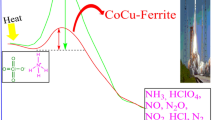Abstract
Copper oxide (CuO) is an attractive burn rate modifier for composite solid propellant based on ammonium perchlorate (AP). However, the mechanism of catalytic decomposition of AP in the presence of CuO is still uncertain. Amount of gaseous products at various decomposition temperatures of AP in the presence and absence of CuO is lacking. Herein, a systematic study using thermogravimetry-mass spectroscopy (TG-MS) was carried out to evaluate the effect of CuO on AP decomposition mechanism. A novel hydrothermal method was reported for the preparation of nanosized copper oxide. The conversion of precursor Cu(NO3)2·3H2O to intermediate Cu2(NO3)(OH)3 was accomplished by in situ carbonization of small quantity of cotton fiber in the hydrothermal reaction chamber. pH of the reaction medium was controlled by utilizing the nitric acid in the reaction medium by in situ carbonization of cotton. This synthetic method aimed to minimize the shape-controlling agents and strong alkali for controlling the pH of the reaction medium for the preparation of catalyst grade CuO. Evolved gas analysis of AP decomposition products by TG-MS showed increased oxygen, chlorine and nitrogen evolution and decreased ammonia evolution in the presence of CuO, compared with that of AP without catalyst. This confirmed the enhanced interaction of ammonia and perchloric acid; the initial decomposition products of AP; and their further reaction in the presence of CuO. The change in composition of volatile products indicates change in mechanism of AP decomposition from proton transfer to electron transfer in the presence of CuO.
Graphical abstract










Similar content being viewed by others
References
Boldyrev VV. Thermal decomposition of ammonium perchlorate. Thermochim Acta. 2006;443:1–36.
Kishore K, Sunitha MR. Effect of transition metal oxides on decomposition and deflagration of composite solid propellant systems. AIAAJ. 1979;17:1118–25.
Juibari NM, Tarighi S. MnCo2O4 nanoparticles with excellent catalytic activity in thermal decomposition of ammonium perchlorate. J Therm Anal Calorim. 2018;133:1317–26.
Pandas HM, Fazli M. Fabrication of MgO and ZnO nanoparticles by the aid of eggshell bioactive membrane and exploring their catalytic activities on thermal decomposition of ammonium perchlorate. J Therm Anal Calorim. 2018;131:2913–24.
Hosseini SG, Ayoman E. Synthesis of α-Fe2O3 nanoparticles by dry high-energy ball-milling method and investigation of their catalytic activity. J Therm Anal Calorim. 2017;128:915–24.
Pearson GS. The role of catalysts in the ignition and combustion of solid propellants. Combust Flame. 1970;14(73–84):19.
Chaturvedi S, Dave PN. Nano-metal oxide: potential catalyst on thermal decomposition of ammonium perchlorate. J Exp Nanosci. 2012;7:205–31.
Patil PR, Krishnamurthy VE, Joshi SS. Effect of Nano-copper Oxide and Copper Chromite on the Thermal Decomposition of Ammonium Perchlorate. Propellants Explos Pyrotech. 2008;33:266–70.
Mahdavi M, Farrokhpour H, Tahriri M. Investigation of simultaneous formation of nano-sized CuO and ZnO on the thermal decomposition of ammonium perchlorate for composite solid propellants. J Therm Anal Calorim. 2018;132:879–93.
Ayoman E, Hosseini SG. Synthesis of CuO nanopowders by high-energy ball-milling method and investigation of their catalytic activity on thermal decomposition of ammonium perchlorate particles. J Therm Anal Calorim. 2016;123:1213–24.
Zheng L, Liu X. Solution-phase synthesis of CuO hierarchical nanosheets at near-neutral pH and near-room temperature. Mater Lett. 2007;61:2222–6.
Lugo-Ruelas M, Amezaga-Madrid P, Esquivel-Pereyra O, Antúnez-Flores W, Piza-Ruiz P, Ornelas-Gutierrez C, Miki-Yoshida M. Synthesis, microstructural characterization and optical properties of CuO nanorods and nanowires obtained by aerosol assisted CVD. J Alloys Compd. 2015;643:S46–50.
Tadjarodi A, Roshani R, Imani MA. Facile and green synthesis of CuO nanowires by mechanochemical method. ChemXpress. 2014;6:25–9.
Wu S, Li F, Zhang L, Li Z. Enhanced field emission properties of CuO nanoribbons decorated with Ag nanoparticles. Mater Lett. 2016;171:220–3.
Bhuvaneshwari S, Gopalakrishnan N. Enhanced ammonia sensing characteristics of Cr doped CuO nanoboats. J Alloy Compd. 2016;654:202–8.
Yang C, Xiao F, Wang J, Su X. 3D flower- and 2D sheet-like CuO nanostructures: microwave-assisted synthesis and application in gas sensors. Sens Actuators B. 2015;207:177–85.
Ba N, Zhu L, Zhang G, Li J, Li H. Facile synthesis of 3D CuO nanowire bundle and its excellent gas sensing and electrochemical sensing properties. Sens Actuators B. 2016;227:142–8.
Ameri B, Saeed S, Davarani H, Roshani R, Moazami HR, Tadjarodi A. A flexible mechanochemical route for the synthesis of copper oxide nanorods/nanoparticles/nanowires for supercapacitor applications—the effect of morphology on the charge storage ability. Jalcom. 2017;695:114–23.
Paulose S, Rajeev R, George BK. Functionalized white graphene—copper oxide nanocomposite: synthesis, characterization and application as catalyst for thermal decomposition of ammonium perchlorate. J Colloid Interface Sci. 2017;494:64–73.
Sun P, Wang S, Zhang T, Li Y, Guo Y. Supercritical hydrothermal synthesis of submicron copper(II) oxide: effect of reaction conditions. Ind Eng Chem Res. 2017;56:6286–94.
Jacobs PWM, Pearson GS. Mechanism of the decomposition of ammonium perchlorate. Combust Flame. 1969;13:419–30.
Vyazovkin S, Wight CA. Kinetics of thermal decomposition of cubic ammonium perchlorate. Chem Mater. 1999;11:3386–93.
Devi TG, Kannan MP, Hema B. Thermal decomposition of cubic ammonium perchlorate—the effect of barium doping. Thermochim Acta. 1996;285:269–76.
Chaturvedi S, Dave PJ. A review on the use of nanometals as catalysts for the thermal decomposition of ammonium perchlorate. Saudi Chem Soc. 2013;17:135–49.
Eslami A, Juibari MM, Hosseini SG. Fabrication of ammonium perchlorate/copper-chromium oxides core-shell nanocomposites for catalytic thermal decomposition of ammonium perchlorate. Mater Chem Phys. 2016;181:12–20.
Joshi SS, Patil PR, Krishnamurthy VN. Thermal decomposition of ammonium perchlorate in the presence of nanosized ferric oxide. Def Sci J. 2008;58(271–272):11.
Acknowledgements
Authors acknowledge Director, VSSC, for the fund.
Author information
Authors and Affiliations
Corresponding author
Additional information
Publisher's Note
Springer Nature remains neutral with regard to jurisdictional claims in published maps and institutional affiliations.
Electronic supplementary material
Below is the link to the electronic supplementary material.
Rights and permissions
About this article
Cite this article
Sivadas, D.L., Thomas, D., Haseena, M.S. et al. Insight into the catalytic thermal decomposition mechanism of ammonium perchlorate. J Therm Anal Calorim 138, 1–10 (2019). https://doi.org/10.1007/s10973-019-08209-5
Received:
Accepted:
Published:
Issue Date:
DOI: https://doi.org/10.1007/s10973-019-08209-5




